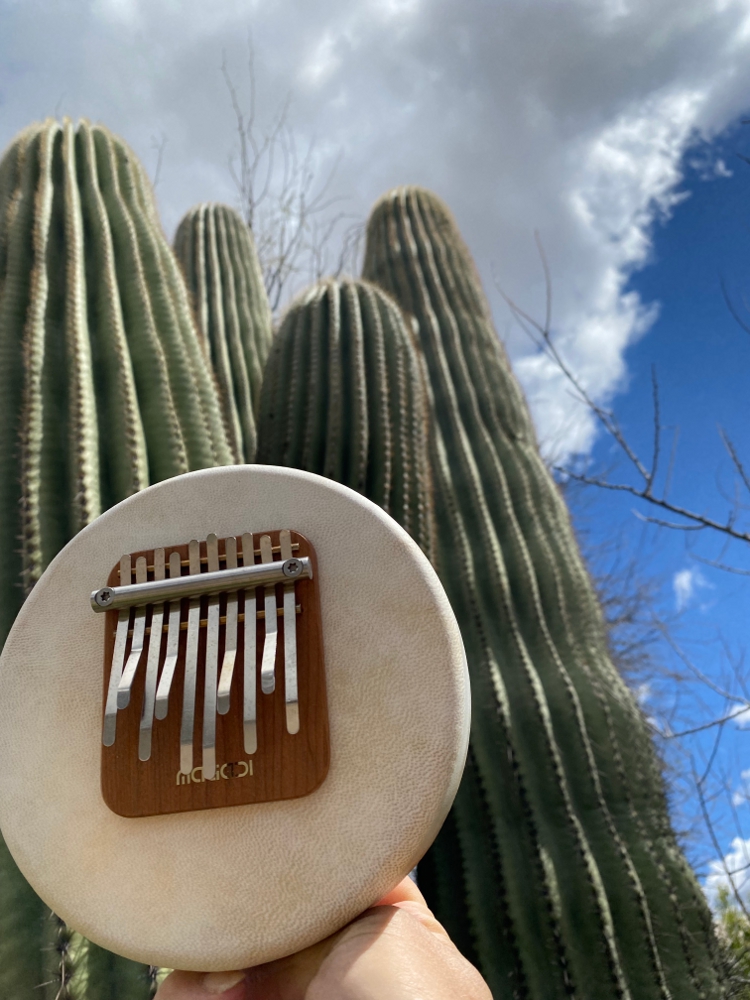
Use of this website constitutes acceptance of the Privacy Policy and User Agreement. Copyright © 2020 Kalimba Magic. All Rights Reserved.
The pentatonic kalimba and the Alto kalimba are a great natural pairing. They can create a gorgeous contrast that works when two players can “jam with deliberate abandon” – meaning players who are technically proficient and can also really move, respond, and dance with each other’s music. The pentatonic’s basic traits contribute to the very attractive alliance it can make with the Alto.
The pentatonic kalimba is a bit of a mystery. It seems so simple – a perfect instrument for a beginner. Everything you play on it sounds great – playing it is a bit like finger painting – you just move your thumbs around and your movements somehow are transformed into beautiful sound. Which is probably why experienced players love jamming with the pentatonic kalimba! It represents freedom, and when you play it, you might very well feel as if you are flying.
In the video below, Serena Gabriel is on the left, playing “lead kalimba” on the Box Pentatonic in F7 Bebey tuning. That tuning in large part gives this song its particular, quirky but happy feel. And that is me on the right, playing “rhythm kalimba” on my trusty old 1980’s vintage Hugh Tracey Alto kalimba.
Here is what is really happening here: The Alto kalimba on the right is playing supportive music. Fewer notes per second, lower notes, a more continuous flow of notes, more predictable repeated phrases… but also instigating chordal or rhythmic changes at strategic locations in the song. It sets a rhythmic and harmonic stage for the Pentatonic kalimba to dance upon.
While Serena is a really good player, part of the success of her lead playing lies in the scale she picked – a certain pentatonic scale used by Francis Bebey in his song Breaths. There is a certain wildness about it, which of course is heightened by Serena’s spirited playing.
But how does that work? How does the pentatonic scale allow you wildness and freedom? Because the pentatonic scale is missing certain notes that could possibly cause a dissonance, which is sort of like a sonic traffic crunch. When you start playing a pentatonic instrument, you realize you don’t have too many options. You steer to the center path, and it just flows. There is no doubt, no uncertainty, and no crunch. You realize that the very possibility of unpleasant sounds is remote, and a boldness takes over. You find your thumbs dancing like never before. Again and again.
Also, most of the various pentatonic scales bring ethnic overtones with them. Here is my own experience of this scale: Playing these notes on this kalimba gives me a feeling of dancing in a rainforest; the scale inspires me to feel as if I am channeling music and spirit from another place and time and culture.
But of course, in a free-form jam, the two musicians are also listening to each other and reacting to each other. Chords change – rhythms change – the volume level and intensity level changes – the fabric of the music swells and shrinks. When you play kalimba with another player, paying close attention and being responsive are the very core of this marvelous, creative endeavor.
A good example of responsiveness in the playing: in the video at 0:15 where Serena starts playing more notes, with intensity, I respond by playing less, in a stable repeating pattern. When she went high, I went low.
You can get these two kalimbas together – with or without electronic pickups – in a great two-kalimba package deal. See the link at the bottom of this post.
Here are three different tuning pairs that I can recommend:
Any of these scale combinations would give you an Alto kalimba capable of more harmonic diversity and support, and a pentatonic kalimba capable of cutting loose and flying.


Sign up for our newsletter and free resources with your email address:
We pinky promise not to spam you and to only send good stuff.
 Assist Paul Tracey Rebuild His House in Pacific Palisades
Assist Paul Tracey Rebuild His House in Pacific Palisades 8-Note Spiral Kalimba Turned into a Student Karimba
8-Note Spiral Kalimba Turned into a Student Karimba Seek to Infuse Your Musical Moments With Beauty and Magic
Seek to Infuse Your Musical Moments With Beauty and MagicUse of this website constitutes acceptance of the Privacy Policy and User Agreement. Copyright © 2020 Kalimba Magic. All Rights Reserved.